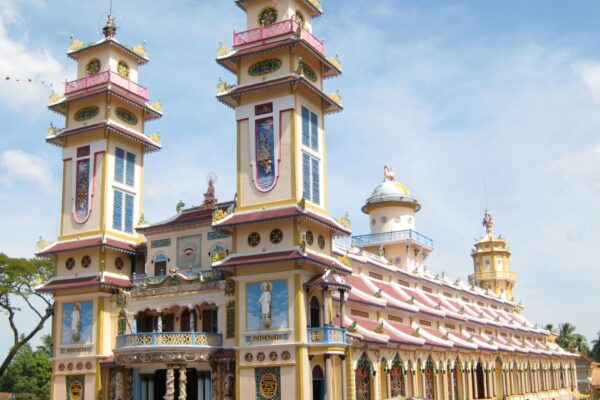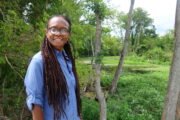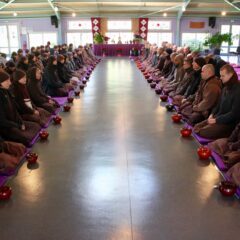An interview with Janet Hoskins
CRCC Communications Director Tim Sato recently interviewed Janet Hoskins, professor of anthropology, a member of CRCC’s Academic Advisory Council. She is author/editor of five books, including Fragments from Forests and Libraries (2001), Anthropology as a Search for the Self (1999), and The Play of Time: Kodi Perspectives on Calendars, History and Exchange (1994). With Macarena Gomez Barris, Prof. Hoskins will convene a CRCC seminar on “Transnational Charisma and Traveling Spirits: How Religion Moves across a Global Landscape” during the 2009-2010 academic year. She is currently engaged in a National Science Foundation project, “Ethnic Resilience and Indigenous Religion: Vietnamese Immigrant Congregations in California.”
Q: Would you please describe your project on Vietnamese indigenous religions?
JH: There are three indigenous religions that are the target of our project, Caodaism, Hoa Hao Buddhism, and Dao Mau. Caodaism, a new religion that was formed when Vietnam was part of French Indochina, is often interpreted as a response to the dislocations of the colonial period. It is a religion that uses the philosophies of Buddhism, Taoism, and Confucianism, but includes within its pantheon, Jesus, Moses, and Mohammad. Caodaists in the colonial period created a new way of being cosmopolitan, but also being Vietnamese. They were influenced by the writings of Victor Hugo, and Descartes, and Rousseau, but at the same time were worshipping their ancestors and felt linked to a very Vietnamese background. The result is a religion that has some of the external organizational forms of the Catholic Church. It has large elaborate churches that look rather like a gothic church in France except they are much more colorful and they are filled with dragons, lotus flowers, and images of snakes crawling around the throne. There’s a very strong Asian imagery within an external shell that is apparently European and the religious belief is similar to the architecture. We have also been looking at Hoa Hao Buddhism, an ascetic form of Buddhism. In its places of worship, there are no images of the Buddha. Instead, people pray to a piece of brown silk that hangs on a very simple altar. They don’t use the traditional Buddhist sutras, but depend on a series of teachings given in verse by a prophet, Huynh Phu So, who emerged in the 1930s in southwestern Vietnam. The Hoa Hao Buddhists have a simple laymen organized religion. In fact, they don’t have any monks. It’s an approachable Vietnamese kind of Buddhism that differs from the teaching of Thich Nhat Hanh, [which is] more focused on an intellectual elite.
Q: Would you please describe Dao Mau and some of its rituals?
JH: Dao Mau, which means literally, “The Way of the Mother Goddesses” is a religion whose rituals take the form of spirit possession ceremonies where people are possessed by a sequence of different spirits and they dance, sometimes speak, distribute gifts, and offer advice. Sometimes they will perform traditional healing with traditional oils. These rituals are in some ways shamanic. The participants say that when they put on the red veil, which they do at the beginning of every ceremony, they release control over their bodies and allow a spirit to come into them. They refer to themselves as the seats for the spirit. They are conscious of being the host to another spirit so they have memory of the event and yet they feel that their bodies move, in essence, without their conscious control. At most of the ceremonies they go through a dozen to two dozen different spirits. The ceremonies will last anywhere from two to eight hours. You’ll see men dancing as very coquettish, feminine princesses and handing out flowers, or scarves, or jewelry. You’ll see women being very fierce generals wielding weapons. After these generals, there is a series of ladies, princesses, and the practice ends with the dance of a couple of child spirits. So this is a performance of different options for your identity, sometimes they’re gendered options, sometimes they are about age, sometimes they are simply reflecting experiences, perhaps of anger or of frustration that people might have.
Q: Can you describe the transnational aspect of your research?
JH: We are interested in the transnational connections that are forged by these religions and the fact that each of these religions began as something specific to the Vietnamese people and now it has a broader global reach. We are looking, in a sense, at the early stages of this expansion. For many other religions we don’t have access to that anymore. Buddhism is also a faith born in India, now practiced primarily in Southeast Asia, but we don’t have much access to its early stages. Here we get to see how spirits travel, what travels with them, how people carry important beliefs inside their bodies, even over a period of 10, 20 or 30 years away from the homeland.
Q: As a summary for the generally interested person, why is this research important?
JH: The armchair anthropologists of the late 19th century believed that as we came into the 20th century we would see the dissolution of religion— that it would simply vanish. We would enter into a rational scientific age and this would no longer be a necessary element of human culture. I think that almost everyone would agree that hasn’t happened. What that tells us is that there are great mysteries that we cannot completely solve with scientific methods and that we need to have sensitivity to the different cultural solutions to these mysteries that people have found in different places. I do believe the anthropological adage that you know yourself better if you look deeply into someone else’s life. I think we Americans, already an extremely diverse group, can learn a lot by paying attention to the different cultures that are in fact part of our own culture now. I also think that religion has shown itself to be both supremely traditional and supremely modern. It’s had a new relevance in the changing circumstances of the 21st century and we need to pay attention to that.






